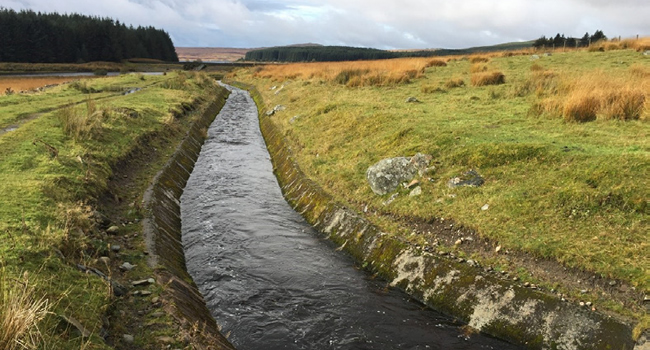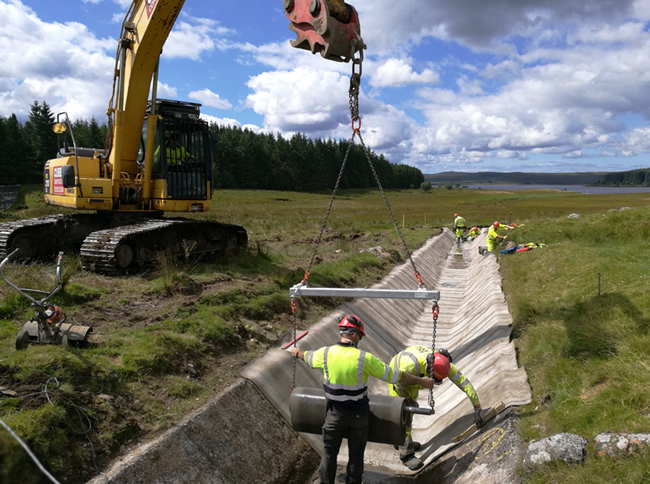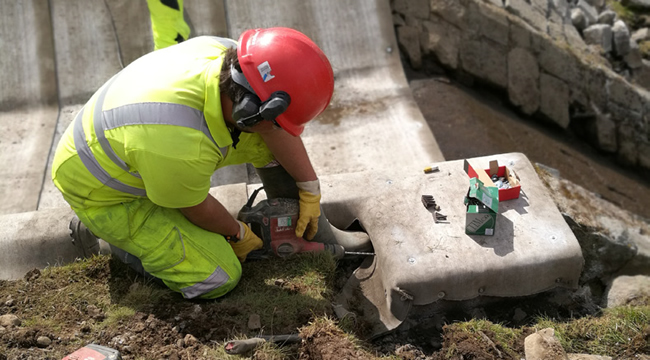In August 2017, a Concrete Canvas® Geosynthetic Cementitious Composite Mat (GCCM) was used to remediate a dilapidated concrete flume, which was part of a hydroelectric system in Dumfries and Galloway, Scotland.
A civil general inspection conducted a few years prior to the remediation found the flume to be in poor condition in significant areas. A few small localized repairs were carried out in 2015, but persistent occurrence of erosion and frost damage led the site operators to seek a more permanent and more financially sound rehabilitation strategy.

CONCRETE FLUME REMEDIATION
The operators had an immediate engineering strategy to draw upon. Not long before, a Concrete Canvas GCCM had been utilized in remediating the Bowburn Flume for Scottish Power. The concrete culvert/aqueduct needing improvement in the Dumfries & Galloway hydroelectric system was not unlike the Bowburn project.
The Muck Burn Flume, as the August 2017 site is known, was constructed around 1935 as part of the Galloway Hydro Scheme. The flume forms part of the Muck Burn Dam civil assets, which are located near Loch Doon. The system feeds into the Drumjohn power station. The flume was created to divert flow from the muck burn to Loch Doon in order to prevent water buildup behind the Muck Dam.

The flume structure is principally comprised of an unreinforced concrete channel cast in situ. The concrete flume is approximately 360m in length and the base varies from 1.1m to 1.6m wide. The sides measure 1.6m, with the existing concrete being 150mm thick.
The Muck Burn Flume, also overseen by Scottish Power, received its commissioned works support for remediation design and construction. Cubby Construction earned the bid, with design consultancy provided by A. L. Daines and Partners. Their work called for 2,000m2 of CC to be installed.
RELATED: Diverting Surface Water from Contaminated Spoils at a Former Mine
MUCK BURN FLUME REHABILITATION
CC5TM had been specified at the previous Bowburn Flume installation, but the increased silt level and debris generated at Muck Burn led the team to specify the slightly more robust CC8TM GCCM.
Prior to installation, the concrete flume was pressure washed to remove vegetation. Minor repairs were carried out using a semi-dry grout mix to fill any voids in the concrete. This process helped ensure intimate contact between the CC and the concrete substrate. The water flow was then diverted into a nearby channel by building an earthen dam and using sandbags. Bulk rolls of CC8TM were then delivered to site in staggered deliveries to reduce onsite storage and to accommodate the speed of the installation crew. The bulk rolls were mounted on a spreader beam, which was hung from a Komatsu PC210LC-7 Hydraulic Excavator.
Rolls of CC were then installed across the width of the flume before being cut to specific profile lengths with an angle grinder. Each length of CC was laid transversely, with adjacent layers overlapped by 100mm in the direction of water flow, and fixed in place using 34mm Hilti nails with 25mm diameter washers shot fired at centers not exceeding 600mm.

Cubby Construction were extremely diligent in preparation and ensured the 100mm overlaps and 600mm Hilti spacing intervals were clearly marked in chalk prior to fastening to ensure the correct interval spacing.
In order to prevent any build-up of hydrostatic pressure between the original concrete slabs and the CC, the joints were left unsealed and free draining. These free draining joints create natural weep paths to allow water ingress into the flume. The end sections of CC were cut with an angle grinder post-set to provide a neat termination. Any inlet areas with direct bank water runoff were either lined with CC or buried in an anchor trench.
The CC material was hydrated after each day’s work using a hose with spray nozzle attachment and a 6000L water carrier.
RELATED: Lining a South African Mine’s Gravity Thickener Tank Floor
The site work for the installation of all 2,000m2 of CC8TM took less than 3 weeks. Only 5 team members were needed to make the installation happen. The CC easily accommodated the sharp bends of the concrete flume and all the related junctions, inlet channels, and interior and exterior pipe protrusions.
An additional benefit to the site is the very low wash-out rate and low alkali reserve with the GCCM material. These characteristics meant that any runoff did not need to be treated.
The Muck Burn Flume now has long-term erosion protection and the site owner’s save significantly on future maintenance needs for the concrete flume.

Learn more about Concrete Canvas materials and read additional case studies at www.concretecanvas.com.











